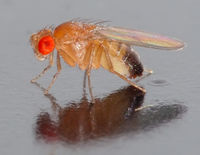CSHL
From 2007.igem.org
Contents |
Engineering fruit fly behavior by remote activation of neurons involved in reward and punishment
Keywords: behavior, remote control, engineering, _Drosophila melanogaster_, Channelrhodopsin-2, blue light, UAS GAL4 system
Team Members
Anh Nguyen
Martin Safrin
Laura Vibert
Liam Wang
Team Advisors
Partha Mitra
Josh Dubnau
Dan Valente
Hontao Qin
Project Description
Background and Motivations
The aim of this project is to engineer a behavior in the common fruit fly. It is well known that the fruit fly is capable of learning through reinforcement, and many experiments in classical and operant conditioning have been done to demonstrate the fly's capacity for learning and memory. By applying reward and punishment in the presence of certain neutral stimuli, the fly can make associations and learn to avoid or seek out these previously neutral stimuli. The current hypothesis in the literature is that, like humans, punishment and reward in insects are mediated by different neurotransmitters. It is believed that in insects, dopamine mediates punishment and octopamine (an invertebrate analog of norepinephrine) mediates reward. In our project we seek to further develop an existing method that allows for direct activation of these putative reward or punishment circuits by application of blue light to the intact animal. We hope to use this method to engineer defined, and even complex, behaviors in the fruit fly by using the blue light flashes to directly ‘reward’ or ‘punish’ behaving animals in real time.
A recently discovered membrane channel protein called[http://www.ncbi.nlm.nih.gov/sites/entrez?Db=pubmed&Cmd=ShowDetailView&TermToSearch=14615590&ordinalpos=3&itool=EntrezSystem2.PEntrez.Pubmed.Pubmed_ResultsPanel.Pubmed_RVDocSum Channelrhodopsin-2], derived from the alga _Chlamydomonas_, has been shown to be usable to remotely activate neurons by shining blue wavelength light (references [[%PUBURL%/%WEB%/RelevantPapers/LIGHTINDUCED.pdf][2]], [[%PUBURL%/%WEB%/RelevantPapers/KineticevaluationofChR2photosensitivity.pdf][3]], [[%PUBURL%/%WEB%/RelevantPapers/InVivoLight-InducedActivationofNeuralCircuitryw.ChR2.pdf][4]]). This channel protein is normally impermeable to ions, that is, it is normally in the closed state. But upon stimulation with blue light, the channel opens and allows permeation by positively charged ions. If this protein channel is transgenically expressed in a neuron, the activation of the channel by blue light causes the influx of positive ions, which in turn causes an action potential to be fired. Research confirms that these artificially induced action potentials can be controlled with great temporal precision by the application of blue light to the neuron or even to an intact brain. Furthermore, it has been shown that in fruit fly larvae, by localizing ChR2 to octopamine releasing neurons, blue light can be used replace naturally rewarding stimuli such as fructose, and by localizing ChR2 to dopamine releasing neurons, blue light can replace naturally punishing stimuli. In other words, the hypothesis that has been confirmed by in the literature is that activating octopaminergic neurons can substitute for a reward to the fly, and activating dopaminergic neurons acts as a punishment [[%PUBURL%/%WEB%/RelevantPapers/DOPAMINEANDOCTOPAMINE.pdf][ref. 5]]. The advantage of using blue light over these naturally rewarding or punishing stimuli however is enormous because it can allow for quick and more temporally precise application of reward or punishment. Moreover, if we are able to use this approach to ‘shape’ the animals behavior, it will directly support the hypothesis that these neurotransmitters convey stimulus value to the animal.
There are two basic kinds of learning that can be applied in the fruit-fly. The first, classical conditioning, also known as Pavlovian conditioning, is the pairing of some neutral stimulus ('conditioned stimulus') with a stimulus that naturally elicits a certain kind of response ('unconditioned stimulus'). Under this procedure the natural response behavior is elicited by the new conditioned stimulus (CS). The classic example is of Pavlov ringing a bell at feeding time for his dogs. The feeding is the unconditioned stimulus that always, naturally, causes salivation. But when the bell is paired with just prior to feeding, pretty soon the bell on its own will come to stimulate a salivation response.
The second kind of conditioning, which we are employing, is called operant conditioning. Operant conditioning differs from classical conditioning in that it reinforces or punishes voluntary behavior. Reinforcement is simply something that increases the frequency of a particular behavior, while punishment decreases the frequency of the behavior. Punishment and reward can be positive or negative. For example, applying positive reinforcement is to give the favorable stimulus in response to a desired behavior. A negative reinforcement is the cessation of constant aversive stimulus, in response to a desired behavior. Positive punishment is the application of an aversive stimulus in response to an undesired behavior, and negative punishment is the removal of a favorable stimulus.
Our approach in engineering the behavior of the fruit-fly is to use operant conditioning as described above to shape their behavior. We will have two sets of populations of fruit-flies. In one, the blue light will serve as the favorable stimulus and in the other the blue light will serve as the aversive stimulus.
